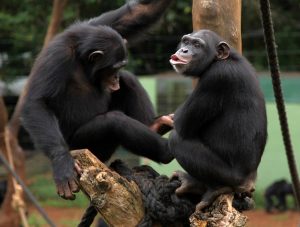When Jane Goodall began her research on chimpanzees, animals were considered naturally peaceful. According to the prevailing doctrine, they did kill their prey, but fights among their own species were so ritualized and controlled by instinctive behaviors that deaths were accidental rather than intentional. According to this point of view, aggression, attacks and wars were “unnatural” behavior that was first developed by humans.
Animal wars observed for the first time
But Goodall had a completely different experience with her chimpanzees in Gombe. The monkey researcher described that violence also occurred within a group of chimpanzees: the males fought to assume the leadership position of their group and did so with physical violence. If the alpha male changed, the researcher was able to observe that it did not shrink from killing the offspring of other males in its own group. This gave the new “boss” of the chimpanzee group the opportunity to mate with the females more quickly. .
And chimpanzees do not only fight for the hierarchy within their own group: Goodall discovered that there were also fights between groups of chimpanzees that went as far as the violent death of individual individuals. Such coordinated and sometimes fatal attacks against other groups of their own kind are what Goodall called outright wars.
Violent by nature
At first, Goodall could only guess why such violent clashes occurred between conspecifics from different groups of chimpanzees. She assumed that the fighting broke out especially when the great apes saw their territory in danger or wanted to conquer new sources of food. Other scientists contradicted this and classified these outbreaks of violence among the chimpanzees as “not natural”. Instead, they hypothesized that proximity to people and their encroachment on living spaces should be the cause of the violence.
An international team of researchers led by Michael Wilson from the University of Minnesota has now proven which of the assumptions is correct. To do this, they examined observational data from 18 different chimpanzee populations, in which more than 150 deaths from attacks by conspecifics had occurred over the course of 50 years.
The result: The acts of violence committed by the great apes occur – as Goodall had suspected – primarily in the struggle for resources and not because humans are contesting their habitat. “We found that human influence had no effect on community killing,” summarizes co-author David Morgan of Chicago’s Lincoln Park Zoo. So violent behavior is actually in the nature of apes.
Great apes also have feelings – and show them
Despite the observed violence between and within the chimpanzee groups, Goodall noticed the very pronounced social behavior of the animals – again a finding that spoke against the prevailing ideas at the time. Among other things, the chimpanzee researcher observed close bonds between the mother animals and their offspring. The mothers took care of their children intensively for years, shared the food with them, groomed their fur and hugged each other.
During her decades of observations, the now recognized researcher also discovered that chimpanzees are not only social, but also feel – and express – emotions such as happiness, love, aggression or depression. For example, Goodall observed a chimpanzee spontaneously dancing next to a waterfall. Today researchers have also observed chimpanzees dancing in captivity.
Goodall later discovered that the animals also express the various emotional states linguistically and learned to decipher the various vocalizations of the chimpanzees. For example, a loud roar signals fear, a gentle moaning astonishment and a soft grunt signal a sense of wellbeing and security. According to the researcher, sexual arousal also leads to what is known as a “copulatory scream” – a piercing squeak.
–


